38 what are three parts to a nucleotide
what are 3 parts of a nucleotide? - Brainly.com The three parts of a nucleotide are: - A phosphate group - Nitrogenous base - Five-carbon atoms. Explanation: These are the three parts that make up a nucleotide. thanks for the help Yeah, for sure Advertisement Advertisement New questions in Biology. What Are the 3 Parts of a Nucleotide.docx - What Are the 3... Both deoxyribonucleic acid (DNA) and ribonucleic acid (RNA) are made up of nucleotides which consist of three parts: 1. Nitrogenous Base Purines and pyrimidines are the two categories of nitrogenous bases. Adenine and guanine are purines. Cytosine, thymine, and uracil are pyrimidines. In DNA, the bases are adenine (A), thymine (T), guanine (G), and cytosine (C).
Nucleotide - Wikipedia Structural elements of three nucleotides—where one-, two- or three-phosphates are attached to the nucleoside (in yellow, blue, green) at center: 1st, the nucleotide termed as a nucleoside monophosphate is formed by adding a phosphate (in red); 2nd, adding a second phosphate forms a nucleoside diphosphate; 3rd, adding a third phosphate results ...

What are three parts to a nucleotide
A nucleotide is made of three parts - wiewird.com A nucleotide is composed of three distinctive chemical sub-units: a five-carbon sugar molecule, a nucleobase—the two of which together are called a nucleoside—and one phosphate group. With all three joined, a nucleotide is also termed a "nucleoside monophosphate", "nucleoside diphosphate" or "nucleoside triphosphate", depending on how many ... What is a nucleotide What are the three parts? - GetAnyAnswer Nucleotides are made up of 3 parts.The first is a distinct nitrogenous base, which is adenine, cytosine, guanine or thymine. The third part of a nucleotide is the pentose (5 carbon) sugar. The pentose sugars found in nucleotides are aldopentoses: ribose in RNA and deoxyribose in DNA. What are the 3 main parts of a nucleotide? - ScienceOxygen A nucleotide is made up of three parts: a phosphate group, a 5-carbon sugar, and a nitrogenous base. The four nitrogenous bases in DNA are adenine, cytosine, guanine, and thymine.
What are three parts to a nucleotide. Glossary - The Cell - NCBI Bookshelf The three-dimensional folding of a polypeptide chain that gives the protein its functional form. testosterone. A steroid hormone produced by the testis. thylakoid membrane. The innermost membrane of chloroplasts that is the site of electron transport and ATP synthesis. thymine. A pyrimidine found in DNA that base-pairs with adenine. thyroid hormone What Are the Three Parts of a Nucleotide? - Science Notes and Projects The three parts of a nucleotide are connected via covalent bonds. The nitrogenous bases bonds to the first or primary carbon atom of the sugar. The number 5 carbon of the sugar bonds to the phosphate group. A free nucleotide may have one, two, or three phosphate groups that attach as a chain to the sugar's 5-carbon. When nucleotides connect ... What are the three parts of a nucleotide? - AssignmentGeek A. Answer: Each nucleotide consists of the following parts: Phosphate group. Pentose sugar. Nitrogenous base (adenine) Biology. What are the Three Parts of a Nucleotide? | Albert.io Mar 01, 2022 · The assembly of nucleotides (1) differentiates them from nucleosides, which do not contain a phosphate group (in the blue box); (2) allows the nucleotide to connect to other nucleotides when the nitrogenous base forms a hydrogen bond with another nucleotide’s nitrogenous base; as well as (3) allows the phosphate to form a phosphodiester bond ...
What are the three main parts of a nucleotide? - whathowinfo.com What are the three different parts of a nucleotide? Both deoxyribonucleic acid (DNA) and ribonucleic acid (RNA) are made up of nucleotides which consist of three parts: Nitrogenous Base. Purines and pyrimidines are the two categories of nitrogenous bases. Pentose Sugar. In DNA, the sugar is 2′-deoxyribose. Phosphate Group. Management of HIV/AIDS - Wikipedia Nucleoside/nucleotide reverse-transcriptase inhibitors. Nucleoside reverse-transcriptase inhibitors (NRTI) and nucleotide reverse-transcriptase inhibitors (NtRTI) are nucleoside and nucleotide analogues which inhibit reverse transcription. HIV is an RNA virus, so it can not be integrated into the DNA in the nucleus of the human cell unless it ... What Are The 3 Parts Of A Nucleotide? - Cooking Tom Thymine in a Nucleotide. A nucleotide is the smallest component of a DNA molecule. There are three major components to a nucleotide, and they are the backbone, deoxyribose sugar, and a nitrogenous base. The backbone is a repeating chain of deoxyribose sugars. The deoxyribose sugar is made up of five carbon atoms, including the glycoside bond. Where are the three components of a nucleotide? Each nucleotide is made up of three components: a nitrogenous base, a pentose (five-carbon) sugar called ribose, and a phosphate group. Each nitrogenous base in a nucleotide is attached to a sugar molecule, which is attached to one or more phosphate groups. What are 3 nucleic acids examples? Examples of Nucleic Acids deoxyribonucleic acid (DNA)
Explanation of 3 Parts of a Nucleotide and Nucleotide Examples - HoneyReads Within the 3 parts of a nucleotide, there are five types of nucleotide bases which are: Adenine (A), Cytosine (C), Guanine (G), Thymine (T) and Uracil (U). When they are combined with sugar, they form nucleotide adenosine, cytidine, guanosine, thymidine, and uridine. 1. Adenine What Are The Three Parts Of A Nucleotide | Jacks Of Science Each nucleotide is composed of three parts: a sugar, a phosphate, and a nitrogen-containing base. The sugar molecule can be either ribose or deoxyribose, and the phosphate group is bonded to the sugar via a phosphodiester bond. The nitrogen-containing base is attached to the sugar via a nitrogenous base pair. What is a phosphate group? The 5 Kinds of Nucleotides - ThoughtCo The five bases are adenine, guanine, cytosine, thymine, and uracil, which have the symbols A, G, C, T, and U, respectively. The name of the base is generally used as the name of the nucleotide, although this is technically incorrect. The bases combine with the sugar to make the nucleotides adenosine, guanosine, cytidine, thymidine, and uridine. What are the three parts of a nucleotide? - Answers A nucleotide is made of three parts. Those parts are: a five carbon ribose sugar, a phosphate molecule, and a nitrogenous base (adenine, guanine, cytosine, or uracil). Related questions What are...
3 Parts of a Nucleotide and How They Are Connected - ThoughtCo Jan 24, 2020 · A free nucleotide may have one, two, or three phosphate groups attached as a chain to the 5-carbon of the sugar. When nucleotides connect to form DNA or RNA, the phosphate of one nucleotide attaches via a phosphodiester bond to the 3-carbon of the sugar of the next nucleotide, forming the sugar-phosphate backbone of the nucleic acid .
Nucleotide - Genome Sep 12, 2022 · A nucleotide is the basic building block of nucleic acids (RNA and DNA). A nucleotide consists of a sugar molecule (either ribose in RNA or deoxyribose in DNA) attached to a phosphate group and a nitrogen-containing base. The bases used in DNA are adenine (A), cytosine (C), guanine (G) and thymine (T).
What are the three parts of a nucleotide? Flashcards | Quizlet What are the three parts of a nucleotide? Phospate, sugur, nitrogen base Nucleotide basic unit surgery in DNA deoxylibonuelic hydrogen bonds hold DNA together covalent bond is sharing of electrons ionic is the attraction between 2 ions 4 nitrogen bases cytosine, thymine, adenine, guanine DNA is a polymer
What Are The Three Parts Of The Nucleotide? - Cooking Tom DNA is made up of two strands of nucleotides. This is held together by a special molecule called the base. The base can hold either a purine or a pyrimidine. The three types of purine are adenine, guanine, and thymine. The three types of pyrimidine are cytosine, uracil, and thymine. The two strands of nucleotides are twisted around each other ...
What are the three parts of a nucleotide? - Toppr Ask >> What are the three parts of a nucleotide Question What are the three parts of a nucleotide? Hard Solution Verified by Toppr Figure shows adenine structure. Nucleotide shown in the figure is divided into nitrogen containing base, sugar backbone and phosphate group. Was this answer helpful? 0 0 Similar questions What are three parts of a nucleus?
Nucleotide - Definition, Structure (3 Parts), Examples & Function Oct 04, 2019 · A nucleotide is an organic molecule that is the building block of DNA and RNA. They also have functions related to cell signaling, metabolism, and enzyme reactions. A nucleotide is made up of three parts: a phosphate group, a 5-carbon sugar, and a nitrogenous base. The four nitrogenous bases in DNA are adenine, cytosine, guanine, and thymine.
What are the 3 main parts of a nucleotide? - ScienceOxygen A nucleotide is made up of three parts: a phosphate group, a 5-carbon sugar, and a nitrogenous base. The four nitrogenous bases in DNA are adenine, cytosine, guanine, and thymine.
What is a nucleotide What are the three parts? - GetAnyAnswer Nucleotides are made up of 3 parts.The first is a distinct nitrogenous base, which is adenine, cytosine, guanine or thymine. The third part of a nucleotide is the pentose (5 carbon) sugar. The pentose sugars found in nucleotides are aldopentoses: ribose in RNA and deoxyribose in DNA.
A nucleotide is made of three parts - wiewird.com A nucleotide is composed of three distinctive chemical sub-units: a five-carbon sugar molecule, a nucleobase—the two of which together are called a nucleoside—and one phosphate group. With all three joined, a nucleotide is also termed a "nucleoside monophosphate", "nucleoside diphosphate" or "nucleoside triphosphate", depending on how many ...
:max_bytes(150000):strip_icc()/dna-versus-rna-608191_sketch_Final-54acdd8f8af04c73817e8811c32905fa.png)



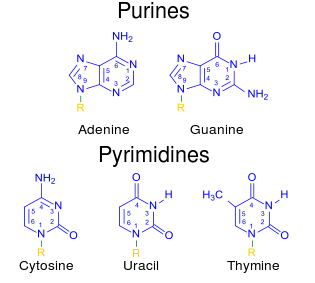
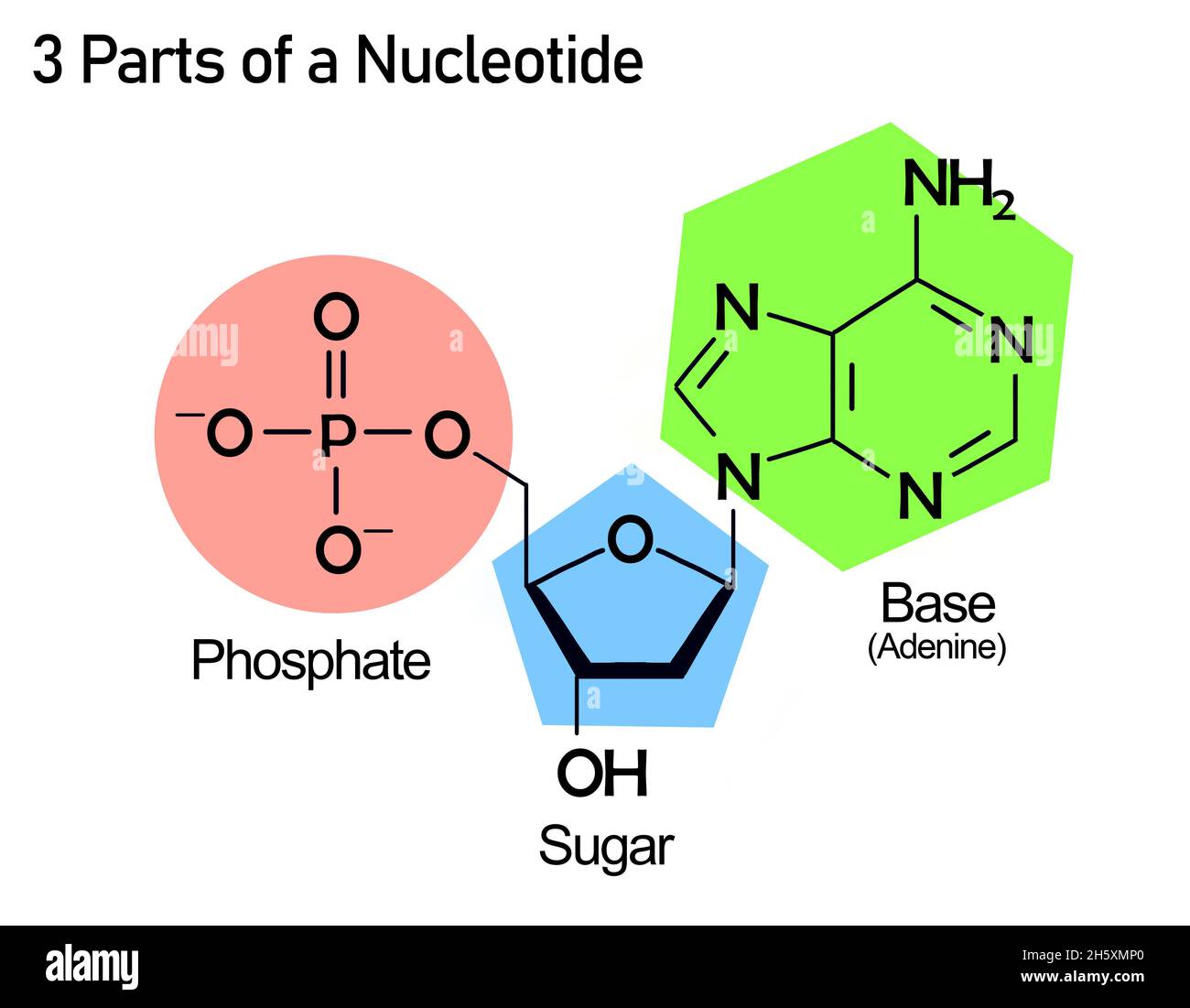
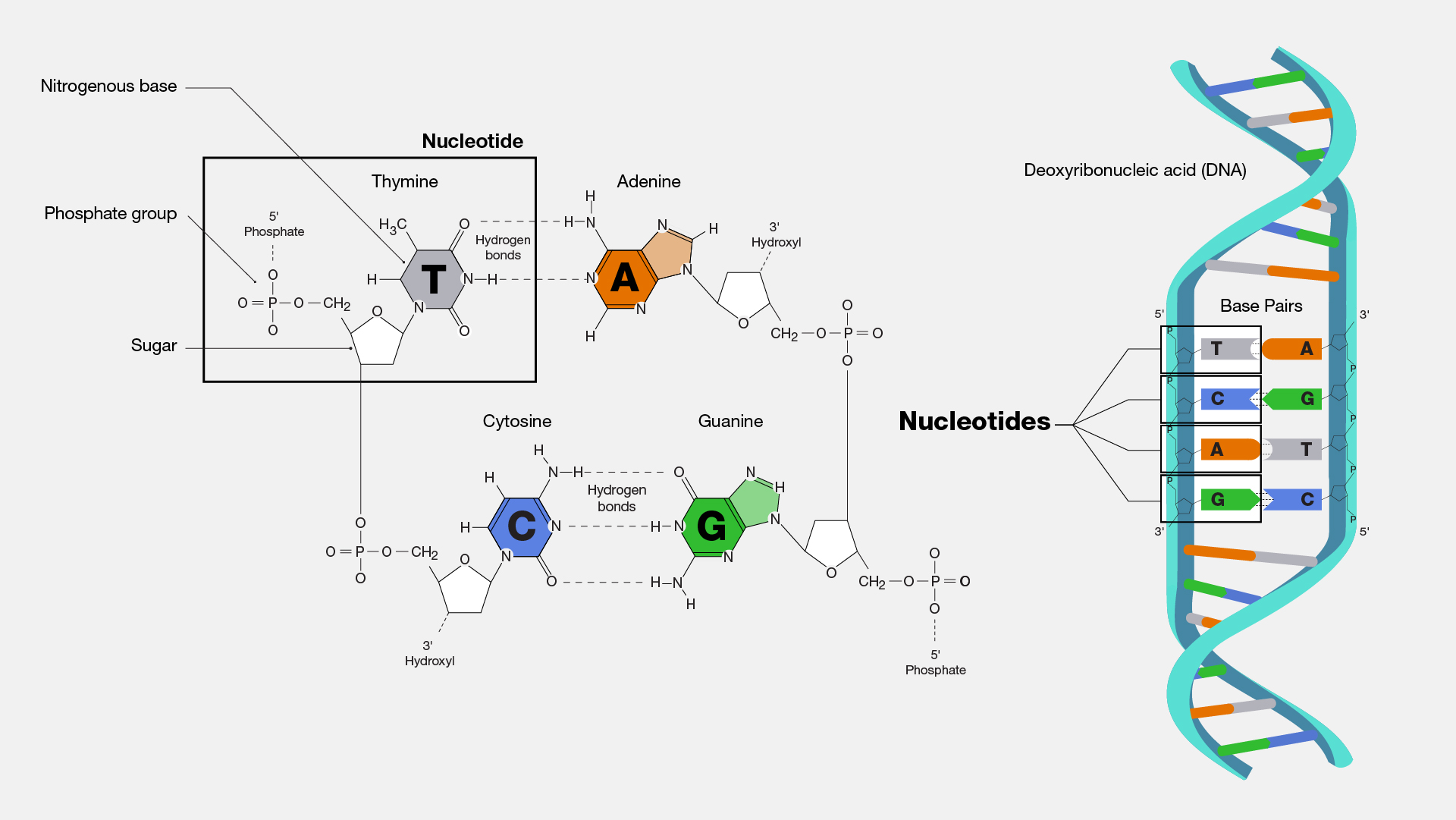


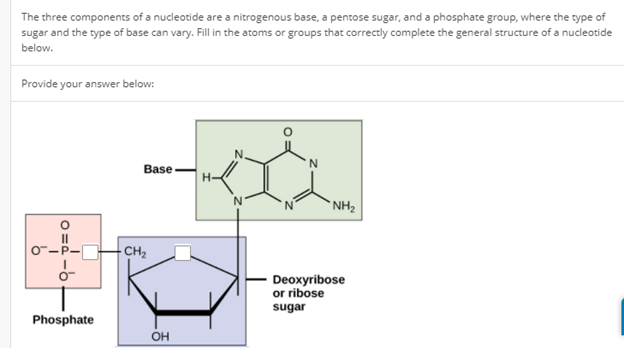

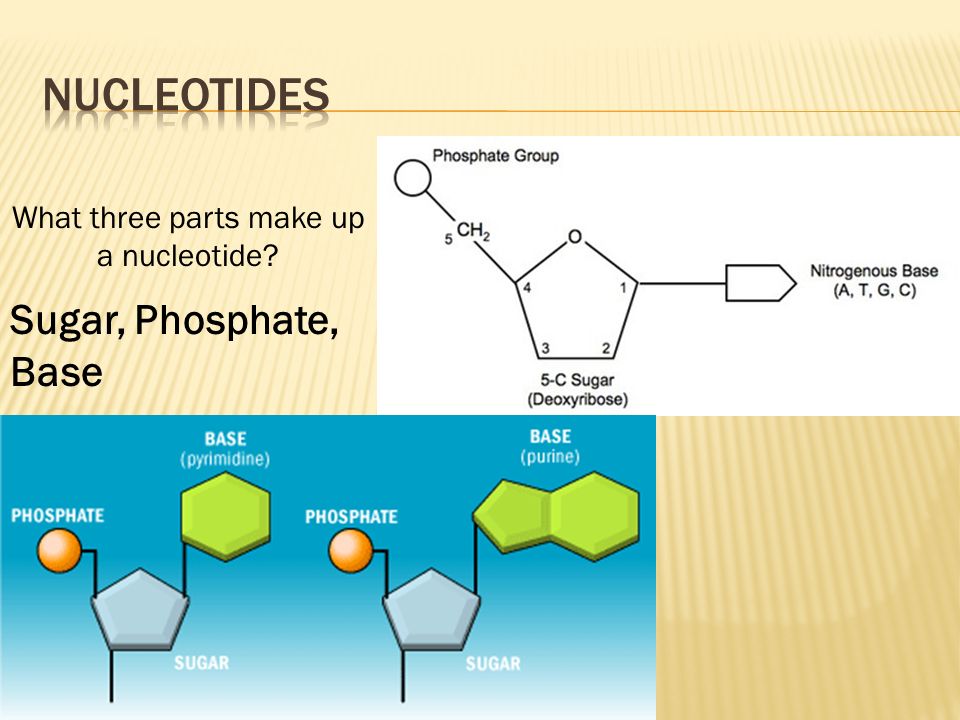





![Best Answer] Use the drop-down menus to label the parts of a ...](https://us-static.z-dn.net/files/d90/1cf9406ccbf0b01925db696bf259bdee.png)




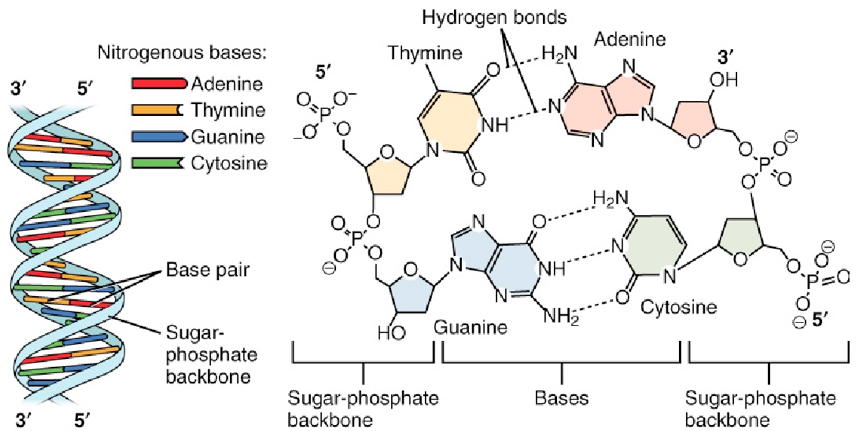











Post a Comment for "38 what are three parts to a nucleotide"